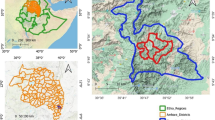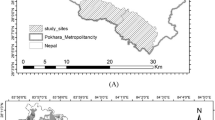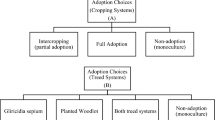Abstract
In Liberia emphases have been placed on reducing deforestation and increasing food security through the transition of smallholder farmers from shifting cultivation to permanent agricultural systems, including tree cropping and agroforestry systems. A structured survey instrument was administered to 80 households in Bong and Lofa counties, Liberia to assess the socio-cultural feasibility of increasing tree cropping and agroforestry practices among smallholder farmers. The survey investigated household use, perceptions and impediments towards tree cropping and agroforestry and livelihood impacts of these practices, including income diversification and food security. Income was the driving motivation for tree cropping, and insecure land tenure was the most significant impediment. Tree cropping households tended to be male-headed, and differed in age distribution. Households that practiced tree cropping had improved income diversification, and those which used agroforestry practices experienced enhanced food security. Respondent perceptions regarding competition between tree crops and herbaceous crops often prevented incorporation of agroforestry practices. Nearly all households practiced shifting cultivation, independent of whether or not they cultivated trees. This suggests that a transition away from shifting cultivation to agroforestry systems will require greater efforts to address socio-political factors, including cultural perceptions and traditions, land tenure, gender, and household demographics.


Similar content being viewed by others
References
ACDI–VOCA (2011) Liberia: livelihood improvement for farming enterprises (LIFE) II. www.acdivoca.org
Achard F, Eva HD, Stibig HJ, Mayaux P, Gallego J, Richards T et al (2002) Determination of deforestation rates of the world’s humid tropical forests. Science 297:999–1002
Alden Wily L (2007) So who owns the forest? An investigation into forest ownership and customary land rights in Liberia. FERN: Brussels—Sustainable Development Institute, Monrovia, Liberia
Altieri M (1995) Agroecology: the science of sustainable agriculture, 2nd edn. Intermediate Technology Publications, London
Altieri M (1999) The ecological role of biodiversity in agroecosystems. Agric Ecosyst Environ 74:19–31
Andow D (1982) The extent of monoculture and its effects on insect pest populations with particular reference to wheat and cotton. Agric Ecosyst Environ 9:25–35
Belsky J (1993) Household food security, farm trees, and agroforestry: a comparative study in Indonesia and the Philippines. Soc Appl Anthro 52(2):130–141
Brady N (1996) Alternatives to slash-and-burn: a global imperative. Agric Ecosyst Environ 58:3–11
Broudic C (2008) Surge in basic commodity prices: Liberia—A case study. ACF International Network, Action Against Hunger. http://liberiadocs.com/2008/06/01/surge-in-basic-commodity-prices-liberia-case-study-062008-acf/. Accessed 3 Sept 2013
Cardoso IM, Guijt I, Franco FS, Carvalho AF, Ferreira Neto PS (2001) Continual learning for agroforestry system design: university, NGO and farmer partnership in Mias Gerais, Brazil. Agric Syst 69:235–257
CIA (2014). CIA World Factbook: Liberia. Central Intelligence Agency. https://www.cia.gov/library/publications/the-world-factbook/geos/li.html. Accessed 17 June 2014
Cooper PJM, Leakey RRB, Rao MR, Reynolds L (1996) Agroforestry and the mitigation of land degradation in the humid and sub-humid tropics of Africa. Exp Agric 32:235–290
Dewees PA, Saxena PA (1997) Farms, trees and farmers: responses to agricultural intensification. In: Arnold JEM, Dewees PA. Earthscan publications Ltd, London
Fairhead J, Leach M (1997) Deforestation in question: dialogue and dissonance in ecological, social and historical knowledge of West Africa. Cases from Liberia and Sierra Leone. Paideuma 43:193–225
FAO (2005) Global forest resources assessment, 2005. United Nations Food and Agriculture Organisation. http://www.fao.org/forestry/fra/fra2005/en/. Accessed online 15 June 2014
FDA (2006) National Forest Management Strategy. Monrovia, Liberia. Forestry Development Authority. http://www.fda.gov.lr/doc/NFMgmtStrategy.pdf. Accessed 4 Sept 2013
Feintrenie LS, Schwarze Levang P (2010) Are local people conservationists? Analysis of transition dynamics from agroforests to monoculture plantations in Indonesia. Ecol Soc 15(4):37
Garrity DP (2004) Agroforestry and the achievement of the millenium development goals. Agrofor Syst 61:5–17
Geist HJ, Lambin EF (2002) Proximate causes and underlying driving forces of tropical deforestation. Bioscience 52(2):143–150
Gibbs HK, Brown S, Niles JO, Foley JA (2007) Monitoring and estimating tropical forest carbon stocks: making REDD a reality. Environ Res Lett 2(4): 045023
ICRAF (2005) Trees of Change: a vision for an agroforestry transformation in the developing world. World Agroforestry Centre
IMF (2011) Lift liberia poverty reduction strategy (PRS)-second annual progress report, 2009–2010, Country Report No. 11/214. Republic of Liberia. International Monetary Fund. http://planipolis.iiep.unesco.org/upload/Liberia/Liberia_PRSP_Progress_Report_April2009_March2010.pdf. Accessed 15 June 2014
Iqbal SMM, Ireland CR, Rodrigo VHL (2006) A logistic analysis of the factors determining the decision of smallholder farmers to intercrop: a case study involving rubber–tea intercropping in Sri Lanka. Agric Syst 87:296–312
Jamnadass R, Place F, Torquebiau E, Malézieux E, Iiyama M, Sileshi GW, Kehlenbeck K, Masters E, McMullin S, Weber JC, Dawson IK (2013) Agroforestry, food and nutritional security. ICRAF Working Paper No. 170. Nairobi, World Agroforestry Centre. http://www.worldagroforestry.org/downloads/publications/PDFs/WP13054.PDF. Accessed 17 Sept 2013
Jessy MD, Varghese P, Punnoose KI, Sethraj MR (1997) Multispecies cropping system with rubber: a preliminary report. In: Proceedings of the symposium on farming system aspects of the cultivation of natural rubber (Hevea brasiliensis). 6 November 1996, Beruwela, Sri Lanka. International Rubber Research and Development Board, Brickendonbury, Hertford, UK, p 81–89
Kiptot E, Franzel S (2011) Gender and agroforestry in Africa: are women participating? World Agroforestry Centre (ICRAF), Nairobi, Kenya. http://www.worldagroforestry.org/downloads/publications/PDFs/OP16988.PDF. Accessed 3 Sept 2013
Kronick J (1984) Temporal analysis of agroforestry systems for rural development. Agrofor Syst 2:165–176
Lal R (1991) Myths and scientific realities of agroforestry as a strategy for sustainable management for soils in the tropics. Adv Soil Sci 15:91–137
Leakey RRB (1998) Agroforestry in the humid lowlands of West Africa: some reflections on future directions for research. Agrofor Syst 40:253–262
LRP (2013) Land Rights Policy. Republic of Liberia, Land Commission. Approved 21 May 2013. http://www.globalprotectioncluster.org/_assets/files/field_protection_clusters/Liberia/Liberia_Land_Rights_Policy_2013_EN.pdf. Accessed online 16 June 2014
Mai PT (1999) Socio-economic analysis of shifting cultivation versus agroforestry system in the upper stream of lower Mekong watershed in Dak Lak province. MA thesis in Economics of Development, National University-HCMC, Viet Nam and Institute of Social Study (ISS), The Netherlands
Malhi Y, Grace J (2000) Tropical forests and atmospheric carbon dioxide trends. Ecol Evol 15:332–337
Mayer K (1951) Forest resources of Liberia. Agricultural Information Bulletin, Forest Service USDA, Washington, p 67
Mayson DTW, Sawyer A (1979) Labour in Liberia. Rev Afr Polit Econ 14:3–15
McLaughlin Russell U (1966) Foreign investment and development in Liberia (Praeger special studies in international economics and development). Frederick A. Praeger Publishers, New York
MOA (2007) Comprehensive assessment of the agriculture sector, vol 1 synthesis report. Ministry of Agriculture. Republic of Liberia, Monrovia, Liberia
MOA (2008) Food and Agriculture policy and strategy: from subsistence to sufficiency. Ministry of Agriculture. Republic of Liberia, Monrovia, Liberia. http://www.gafspfund.org/sites/gafspfund.org/files/Documents/Liberia_5_of_%207_FAPS_Food_Agriculture_Strategy_0.pdf. Accessed 4 Sept 2013
MOA (2010) Findings: Liberia household food security and nutrition surveillance conducted in November–December 2009. Ministry of Agriculture. Republic of Liberia, Monrovia, Liberia. http://documents.wfp.org/stellent/groups/public/documents/ena/wfp216597.pdf. Accessed 15 June 2014
MoFa (2003) An act to govern the devolution of estates and establish rights of inheritance for spouses of both statutory and customary marriages. Ministry of Foreign Affairs. Republic of Liberia. http://www.refworld.org/pdfid/44868b524.pdf. Accessed 4 Sept 2013
Montagnini F, Nair PKR (2004) Carbon sequestration: an underexploited environmental benefit of agroforestry systems. Agrofor Syst 61:281–295
Myers N, Mittermeier RA, Mittermeier CG, da Fonseca GAB, Kent J (2000) Biodiversity hotspots for conservation priorities. Nature 403:853–858
Nair PKR (1985) Classification of agroforestry systems. Agrofor Syst 3:97–128
Nath TK, Inoue M, Myant H (2005) Small-scale agroforestry for upland community development: a case study from Chittagong HIll tracts, Bangladesh. J For Res 10:443–452
NFRL (2006) An act adopting the national forestry reform law of 2006. Republic of Liberia, Monrovia, Liberia
Oduol PA, Aluma JRW (1990) The banana (Musa spp.)—Coffee robusta: traditional agroforestry system of Uganda. Agrofor Syst 11:213–226
Okafor JC, Fernandes ECM (1987) Compound farms of southeastern Nigeria: a predominant agroforestry homegarden system with crops and small livestock. Agrofor Syst 5:153–168
Penot E (2004) From shifting agriculture to sustainable rubber agroforestry systems (jungle rubber) in Indonesia: a history of innovations processes. In: Penot E (ed) Beyond tropical deforestation. CIRAD-TERA, p 221–250. http://hal.archives-ouvertes.fr/docs/00/17/33/02/PDF/BOOK_CHAPTER_unesco_2003_af_pENOT.pdf. Accessed online 17 Sept 2013
Rahman SA, Rahman MF, Sunderland T (2012) Causes and consequences of shifting cultivation and its alternative in the hill tracts of eastern Bangladesh. Agrofor Syst 84:141–155
Raintree JB, Warner K (1986) Agroforestry pathways for the intensification of shifting cultivation. Agrofor Syst 4:39–54
Rodrigo VHL, Nugawela A, Sivanathan A, Witharama WRG, Jayasinghe WK (2000) Rubber cum sugarcane intercropping a suitable cropping system for the farmers in the intermediate zone of Sri Lanka. J. Rubber Res Inst Sri Lanka 83:62–74
Rodrigo VHL, Stirling CM, Silva TUK, Pathirana PD (2005) The growth and yield of rubber at maturity is improved by intercropping with banana during the early stage of rubber cultivation. Field Crops Res 91:23–33
R-PIN (2008) Liberian Readiness Plan Idea Note. http://www.forestcarbonpartnership.org/fcp/sites/forestcarbonpartnership.org/files/Liberia_FCPF_R-PIN.pdf. Accessed 17 June 2014
R-PP (2012) Readiness preparation proposal for country: Republic of Liberia, Approved: Resolution PC/9/2011/2-final version. Forest Carbon Partnership Facility (FCPF) and United Nations REDD Programme (UN-REDD). http://www.forestcarbonpartnership.org/sites/forestcarbonpartnership.org/files/Documents/PDF/Apr2012/Liberia%20R-%20PP_revised_April%202012.pdf. Accessed online: 15 June 2014
Sanchez PA, Shepherd KD, Soule MJ, Place FM, Buresh RJ, Izac AM, Mokwunye AU, Kwesiga FR, Nderitu CG, Woomer PL (1997) Soil fertility replenishment in Africa: an investment in natural resource capital. In: Buresh RJ, Sanchez PA, Calhoun FG (eds) Replenishing soil fertility in Africa. SSSA Special Publication Number 51. Soil Science Society of America, Madison, p 1–46
Sanchez PA, Jama B, Niang AI, Palm CA (2001) Soil fertility, small farm intensification, and the environment in Africa. In: Lee D, Barret C (eds) Tradeoffs or synergies? Agricultural intensification, economic development, and the environment. CAB International, Wallingford, pp 342–344
Scherr SJ (1991) On-farm research: the challenges of agroforestry. Agrofor Syst 15:95–110
Schroth G, Da Fonseca GAB, Harvey CA, Gascon C, Vasconcelo HL, Izac AM (2004) Agroforestry and biodiversity conservation in tropical landscapes. Island Press, Washington, p 9
SDI (2013) Multi-stakeholder dialogue (MSD) on the land rights policy: civil society response to the land rights policy. Sustainable Development Institute,Duarzon,Liberia
Sheil D, Puri R, Wan M, Basuki I, van Heist M, Liswanti N, Rachmatika I, Samsoedin I (2006) Recognizing local people’s priorities for tropical forest biodiversity. Ambio 35(1):17–24
Tajuddin I (1986) Integration of animals in rubber plantations. Agrofor Syst 4:55–66
UNDP (2006) First state of the environment report for Liberia-2006.United Nations Development Programme
UNDP (2013) International Human Development Indicators. United Nations Development Programme. 17 April 2013. http://hdrstats.undp.org/en/countries/profiles/LBR.html
Unruh JD (2009) Land rights in postwar Liberia: the volatile part of the peace process. Land Use Policy 26:425–433
USDA (2000) Measuring food security in the united states: guide to measuring household food security, Revised. United States Department of Agriculture
Voorhoeve AG (1979) Liberian high forest trees, Wageningen: Centre for agricultural publishing. Report 65
Weise S, Wilcox Jr, MD (2007). Tree Crops to ensure income generation and sustainable livelihoods in Liberia. IITA/STCP. http://trend.ag.utk.edu/international/IITASTCPTreeCropReport.pdf Accessed 27 Aug 2014
World Bank (2010) Mainstreaming social and environmental considerations into the liberian national forestry reform process: a strategic environment assessment for implementation of the 3Cs of the Forest Reform Law 2006. http://siteresources.worldbank.org/EXTARD/Resources/336681-1285969000707/LiberiaForestSEA.pdf Accessed 4 Sept 2013
World Bank (2012) Readiness preparation proposal assessment note on a proposed grant in the amount of US$3.6 million to the Republic of Liberia for REDD+ readiness preparation support from the forest carbon partnership Fund (FCPF)
Wunder S (2001) Poverty alleviation and tropical forests: what scopr for synergies? World Dev 29(11):1817–1833
Acknowledgments
We give special thanks to the Liberian respondents who graciously participated in our survey. We personally thank Stephen S. Paye and the other students who helped make this study a success. We are grateful to Rebecca Hardin, Ph.D., Stephanie Hart, M.S., Rohit Warrier, Ph.D., Jason Martina, Ph.D, Bilal Butt, Ph.D., Brady West, Ph.D., and the Currie lab group for their valuable insights and contributions. Special thanks are offered to Amy Deal, ACDI–VOCA, the E-HELD program, Sara Rimer, Jose Alfaro Ph.D., and Sustainability without Borders, for their assistance with in-country logistics. The survey and statistical methods were developed with consultation from the Social Research Institute and the Center for Statistical Consultation and Research (CSCAR), respectively, at the University of Michigan, Ann Arbor, MI. This study was supported by grants from the African Studies Center, the School of Natural Resources and Environment and Rackham Graduate School at the University of Michigan, as well as a US Forest Service McIntire-Stennis grant to William Currie.
Author information
Authors and Affiliations
Corresponding author
Rights and permissions
About this article
Cite this article
Fouladbash, L., Currie, W.S. Agroforestry in Liberia: household practices, perceptions and livelihood benefits. Agroforest Syst 89, 247–266 (2015). https://doi.org/10.1007/s10457-014-9763-9
Received:
Accepted:
Published:
Issue Date:
DOI: https://doi.org/10.1007/s10457-014-9763-9




